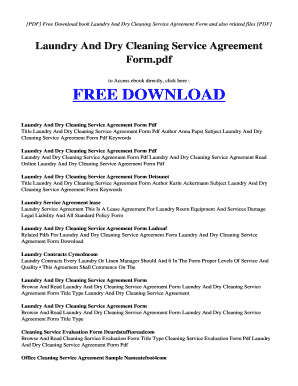Fill and Sign the Laundry Service Contract Sample Form

Useful advice on finalizing your ‘Laundry Service Contract Sample’ digitally
Are you fed up with the inconvenience of managing documentation? Look no further than airSlate SignNow, the top electronic signature service for individuals and businesses. Bid farewell to the lengthy process of printing and scanning documents. With airSlate SignNow, you can effortlessly finalize and sign documents online. Utilize the powerful features integrated into this easy-to-use and cost-effective platform and transform your strategy for document management. Whether you need to authorize forms or collect electronic signatures, airSlate SignNow manages it all seamlessly, with just a few taps.
Adhere to this comprehensive guide:
- Log into your account or sign up for a complimentary trial with our service.
- Click +Create to upload a document from your device, cloud storage, or our template library.
- Access your ‘Laundry Service Contract Sample’ in the editor.
- Click Me (Fill Out Now) to set up the form on your end.
- Add and designate fillable fields for others (if necessary).
- Move forward with the Send Invite options to solicit eSignatures from others.
- Save, print your version, or convert it into a reusable template.
Don’t fret if you need to work with your colleagues on your Laundry Service Contract Sample or send it for notarization—our solution offers everything you require to accomplish such tasks. Register with airSlate SignNow today and elevate your document management to new levels!
FAQs
-
What is a Laundry Service Contract Sample?
A Laundry Service Contract Sample is a template that outlines the terms and conditions of laundry services provided by a business. This sample helps ensure clarity between service providers and customers regarding pricing, services included, and responsibilities. By using a Laundry Service Contract Sample, businesses can streamline their operations and enhance customer satisfaction.
-
How can I customize a Laundry Service Contract Sample for my business?
Customizing a Laundry Service Contract Sample is easy with airSlate SignNow. You can modify the template to include specific details such as pricing, service hours, and additional services offered. This flexibility allows you to create a tailor-made contract that meets your unique business needs.
-
What are the benefits of using a Laundry Service Contract Sample?
Using a Laundry Service Contract Sample provides numerous benefits, including establishing clear expectations between parties and protecting both the service provider and customer. It minimizes misunderstandings and disputes by clearly outlining services, pricing, and responsibilities. Additionally, having a well-defined contract can enhance your brand's professionalism.
-
How does airSlate SignNow facilitate the signing of a Laundry Service Contract Sample?
AirSlate SignNow simplifies the signing process of a Laundry Service Contract Sample by providing an intuitive e-signature platform. Users can easily upload their contract, send it to clients for signature, and track its status in real time. This seamless process saves time and ensures that contracts are signed promptly and securely.
-
What features should I look for in a Laundry Service Contract Sample?
A comprehensive Laundry Service Contract Sample should include key elements such as service descriptions, pricing structures, payment terms, and cancellation policies. Additionally, it should address liability and dispute resolution to protect both parties. AirSlate SignNow's templates often include these essential features, making contract creation straightforward.
-
Is there a cost associated with using a Laundry Service Contract Sample?
While the Laundry Service Contract Sample itself can often be found for free online, using airSlate SignNow may involve subscription fees based on your chosen plan. However, the cost is generally outweighed by the time savings and increased efficiency provided by the platform. Investing in a reliable e-signature solution can greatly enhance your business operations.
-
Can I integrate airSlate SignNow with other software for my Laundry Service business?
Yes, airSlate SignNow offers integration capabilities with various software applications, allowing you to streamline your workflow. You can integrate tools like CRM systems, project management software, and accounting solutions to enhance your Laundry Service operations. This flexibility ensures that your Laundry Service Contract Sample fits seamlessly into your existing processes.
Related searches to laundry service contract sample form
Find out other laundry service contract sample form
- Close deals faster
- Improve productivity
- Delight customers
- Increase revenue
- Save time & money
- Reduce payment cycles

